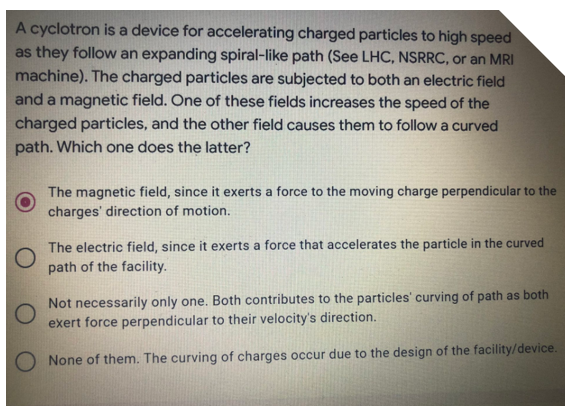A cyclotron is a device for accelerating charged particles to high speed as they follow an expanding spiral-like path (See LHC, NSRRC, or an MRI machine). The charged particles are subjected to both an electric field and a magnetic field. One of these fields increases the speed of the charged particles, and the other field causes them to follow a curved path. Which one does the latter?
A cyclotron is a device for accelerating charged particles to high speed as they follow an expanding spiral-like path (See LHC, NSRRC, or an MRI machine). The charged particles are subjected to both an electric field and a magnetic field. One of these fields increases the speed of the charged particles, and the other field causes them to follow a curved path. Which one does the latter?
Glencoe Physics: Principles and Problems, Student Edition
1st Edition
ISBN:9780078807213
Author:Paul W. Zitzewitz
Publisher:Paul W. Zitzewitz
Chapter26: Electromagnetism
Section: Chapter Questions
Problem 1STP
Related questions
Question

Transcribed Image Text:A cyclotron is a device for accelerating charged particles to high speed
as they follow an expanding spiral-like path (See LHC, NSRRC, or an MRI
machine). The charged particles are subjected to both an electric field
and a magnetic field. One of these fields increases the speed of the
charged particles, and the other field causes them to follow a curved
path. Which one does the latter?
The magnetic field, since it exerts a force to the moving charge perpendicular to the
charges' direction of motion.
The electric field, since it exerts a force that accelerates the particle in the curved
path of the facility.
Not necessarily only one. Both contributes to the particles' curving of path as both
exert force perpendicular to their velocity's direction.
None of them. The curving of charges occur due to the design of the facility/device.
Expert Solution
This question has been solved!
Explore an expertly crafted, step-by-step solution for a thorough understanding of key concepts.
This is a popular solution!
Trending now
This is a popular solution!
Step by step
Solved in 2 steps

Knowledge Booster
Learn more about
Need a deep-dive on the concept behind this application? Look no further. Learn more about this topic, physics and related others by exploring similar questions and additional content below.Recommended textbooks for you

Glencoe Physics: Principles and Problems, Student…
Physics
ISBN:
9780078807213
Author:
Paul W. Zitzewitz
Publisher:
Glencoe/McGraw-Hill

Physics for Scientists and Engineers, Technology …
Physics
ISBN:
9781305116399
Author:
Raymond A. Serway, John W. Jewett
Publisher:
Cengage Learning

College Physics
Physics
ISBN:
9781285737027
Author:
Raymond A. Serway, Chris Vuille
Publisher:
Cengage Learning

Glencoe Physics: Principles and Problems, Student…
Physics
ISBN:
9780078807213
Author:
Paul W. Zitzewitz
Publisher:
Glencoe/McGraw-Hill

Physics for Scientists and Engineers, Technology …
Physics
ISBN:
9781305116399
Author:
Raymond A. Serway, John W. Jewett
Publisher:
Cengage Learning

College Physics
Physics
ISBN:
9781285737027
Author:
Raymond A. Serway, Chris Vuille
Publisher:
Cengage Learning

College Physics
Physics
ISBN:
9781305952300
Author:
Raymond A. Serway, Chris Vuille
Publisher:
Cengage Learning

Physics for Scientists and Engineers with Modern …
Physics
ISBN:
9781337553292
Author:
Raymond A. Serway, John W. Jewett
Publisher:
Cengage Learning

Physics for Scientists and Engineers
Physics
ISBN:
9781337553278
Author:
Raymond A. Serway, John W. Jewett
Publisher:
Cengage Learning